


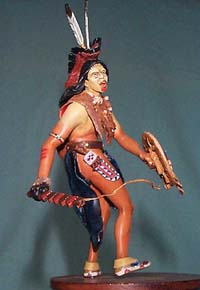 PiliPili
Resin Kit Fox Sioux - 'Iron Hand'
PiliPili
Resin Kit Fox Sioux - 'Iron Hand'
by Stephen Jamison
Background
The Kit Fox society of the Sioux nation were in general terms the 'police' of the tribe, given the task of keeping order and paramountly, the defence of the tribe from outside attack. They were among the bravest of all Native American Societies. This kit depicts the "whip bearer" the 2nd in command of the Society whose job it was to maintain discipline with in the band and prevent abuses of power by Society members. So much for the background to the figure, what is the kit like?
The Kit
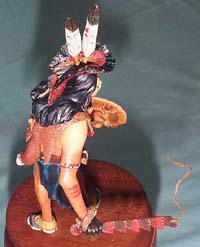 I
have been hooked on Native Americans for the past four years. I saw this
kit advertised shortly before the 1999 Euro Militaire at Folkestone and
I made the PiliPili stand my first stop on my arrival at the show, cash
in hand. I was not disappointed, it is yet another gem from them. Although
Native American subjects had their heyday of popularity some 5/6 years
ago they are still very popular and with figures such as this will remain
so for some time to come.
I
have been hooked on Native Americans for the past four years. I saw this
kit advertised shortly before the 1999 Euro Militaire at Folkestone and
I made the PiliPili stand my first stop on my arrival at the show, cash
in hand. I was not disappointed, it is yet another gem from them. Although
Native American subjects had their heyday of popularity some 5/6 years
ago they are still very popular and with figures such as this will remain
so for some time to come.
Made in a neutral grey resin as per normal with PiliPili figures, this kit comes in 19 parts, although only 18 are needed, Lee van Quang has thoughtfully included an extra feather. The parts needed minimal cleaning up, with just the merest hint of a mould line on the arms legs and torso and some sharping of edges for the plugs that hold eack part in position. Iron hand is a very dramatic figure, posed in mid-turn with his breechclout and fox skin poncho flapping behind him.
Assembly/Painting
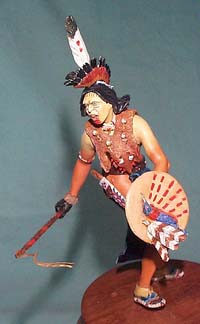 I
first assembled the legs and torso, which includes the face and makes
up the main part on the figure. The Kit Fox Society used similar war paint,
the upper body, upper arms, head is yellow with red, and black religious
marks and symbols. The Osprey book 'American Plains Indian' shows a Kit
Fox although some of the details are inaccurate. I could not find any
other illustrated source, but Quang's suggested scheme is based on detailed
historical research, so the box art can be trusted to be accurate. For
the yellow, I used Windsor & Newton Pale Naples Yellow, which was applied
over a white primer to give the base colour for the upper figure. The
remainder was undercoated with Humbrol "Flesh" with a little Windsor &
Newton Burnt Sienna added to "redden" it up a bit. Once my base colours
were dry, I glazed them this almost transparent coats of oil colour as
follows:
I
first assembled the legs and torso, which includes the face and makes
up the main part on the figure. The Kit Fox Society used similar war paint,
the upper body, upper arms, head is yellow with red, and black religious
marks and symbols. The Osprey book 'American Plains Indian' shows a Kit
Fox although some of the details are inaccurate. I could not find any
other illustrated source, but Quang's suggested scheme is based on detailed
historical research, so the box art can be trusted to be accurate. For
the yellow, I used Windsor & Newton Pale Naples Yellow, which was applied
over a white primer to give the base colour for the upper figure. The
remainder was undercoated with Humbrol "Flesh" with a little Windsor &
Newton Burnt Sienna added to "redden" it up a bit. Once my base colours
were dry, I glazed them this almost transparent coats of oil colour as
follows:
Upper body and face:
· Base colour: Pale Naples Yellow.
· Highlights - Titanium White with the merest touch of Pale Naples Yellow
added just to take the harshness of the white.
· Mid shadow: 1 part Gold Ochre 2 parts Pale Naples Yellow.
· Deep shadow: Slightest touch of Burnt Umber, well blended in.
On the "flesh areas"
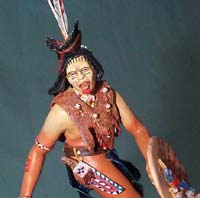 ·
Base colour: 1 part Burnt Sienna, 1 part Gold Ochre, 9 parts Titanium
White.
·
Base colour: 1 part Burnt Sienna, 1 part Gold Ochre, 9 parts Titanium
White.
· Shadows: Base colour with 1 part white instead of 9.
· Deep Shadows: Burnt Umber.
· Highlight: W&N Flesh Tint.
· Very high highlight: Titanium White with hint of base colour.
All highlights and shading were done "wet on wet" and proved very effective.
The arms were attached and needed a little filing around the joins. They were then painted in the same way with the yellow war paint extending half way down the upper arm.
The figure is wearing a breechclout, which is somewhat longer than you may expect but is perfectly normal for Kit Foxes. I painted it Prussian Blue with Titanium White highlights well blended in and Lamp Black sparingly blended into the shadows.
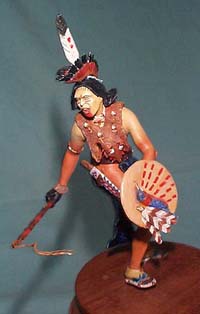 Society
members tended to wear a kit fox pelt and this figure wears his poncho
style. My research showed the kit fox to have a significant amount of
grey fur when compared to its European cousin; however, as those seeing
my finished figure would be European, I decided to use artistic licence
and paint mine as per European foxes to avoid confusion with wolf skins.
Over a base coat of Humbrol matt "Leather" I brushed in a thin coat of
Burnt Umber for depth and then dry brushed Burnt Sienna and an orange
tint made from Cadmium Red and Jaune Brilliant. I finally painted the
tip of the tail white and introduced a little white "well blended" to
the extreme edges of the belly. The skin was lined with a piece of trade
blanket so I painted this in Cadmium Red, and when dry fixed it to the
figure.
Society
members tended to wear a kit fox pelt and this figure wears his poncho
style. My research showed the kit fox to have a significant amount of
grey fur when compared to its European cousin; however, as those seeing
my finished figure would be European, I decided to use artistic licence
and paint mine as per European foxes to avoid confusion with wolf skins.
Over a base coat of Humbrol matt "Leather" I brushed in a thin coat of
Burnt Umber for depth and then dry brushed Burnt Sienna and an orange
tint made from Cadmium Red and Jaune Brilliant. I finally painted the
tip of the tail white and introduced a little white "well blended" to
the extreme edges of the belly. The skin was lined with a piece of trade
blanket so I painted this in Cadmium Red, and when dry fixed it to the
figure.
The figure's long hair and "roache" were painted and fixed in place. The black hair highlighted with a Lamp Black, Prussian Blue, Titanium White mix. The roach was constructed of black turkey feathers fringed with deer hair dyed red and held in place by a silver base plate to which two eagle feathers were attached vertically. The shield was painted and attached as per the box art and the club/whip incorporating the right hand was also painted and attached. For the whip itself, I plaited four strands of 5amp fuse wire together except for the last 5mm and painted it with a mixture of Gold Ochre and Burnt Sienna. The hand was painted black and highlighted with well-blended Burnt Sienna over the knuckles etc.
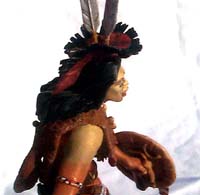 The
dagger and sheath was painted in a similar pattern and using much the
same colours as the box art and attached to the figure. At this point
I attached the figure to a base and painted the moccasins. You may use
your imagination here within some limits, tribes tended to use certain
colours of beads depending on who they traded with etc. but a little research
will give you many variations of colur and pattern to choose from.
The
dagger and sheath was painted in a similar pattern and using much the
same colours as the box art and attached to the figure. At this point
I attached the figure to a base and painted the moccasins. You may use
your imagination here within some limits, tribes tended to use certain
colours of beads depending on who they traded with etc. but a little research
will give you many variations of colur and pattern to choose from.
Finally
The figure is such a dramatic one that I decided that any ground work would detract from the finished figure and so I mounted him on a plain base on one foot in the act of turning. It is an excellent and affordable kit, produced to a standard that other manufacturers have to match, and I thoroughly enjoyed it.
This kit may still be obtained through Historex Agents

Previous: Contents







